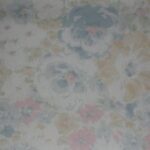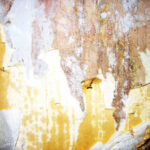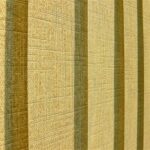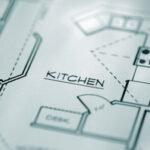When I bought my old home in 1988, it came with the most ugly kitchen wallpaper I had ever seen. Or so I thought, until I pulled the old wallpaper off and found even uglier wallpaper underneath.
Instead of removing the old wallpaper, the person who did the job just slapped another covering over it. The original, covered in dirt and grease stains, was a mess. Yuck.
The proper thing was, of course, would have been to remove the old paper, clean the walls and then put up the new paper. Cheap is as cheap does.
I removed the paper wallpaper by simply yanking it off the wall- leaving most of the glue behind, and taking paper off the wallboard, which then needed repair. Oops.
In the hallway bathroom, vinyl wallpaper covered in 1970’s “autumn gold flowers” was also removed by hand pulling. This was getting to be a problem.
After countless hours sanding and vacuuming off glue and repairing wallpaper bald spots, I began to learn how to remove wallpaper without damaging the walls. This saved tons of work, and my wallet.
First
Determine what how many layers of wallpaper and paint you are removing. If there are multiple layers and the wallboard isn’t stable, perhaps hiring a professional is in order.
This is going to be a lot of work, but it is a DIY job.
You will need:
• Wall Paper Stripper Solution- available from your local DIY store. Read the container and talk to salespersons. There are different brands, concentrates, gels and solutions.
• Scrapers of various sizes- wide is better. Some come with handles that allow more power when you’re pulling off layers of old paint and paper.
• Wallpaper steamer- rent this machine from your local rental or DIY store. Follow the instructions for its use to the letter.
• Heavy work gloves- to protect your hands.
• Scrubbers- barbeque scrubbers work well on wallpaper paste. Green kitchen scrubbers will leave little tiny green bits (trust me) that are a pain to get off the wall.
• Safety goggles- you don’t want anything flying off the wall into your eyes.
• Wallpaper scoring tool- this is essential, and is the easiest to use.
• Regular garden pump sprayer- one or two gallon sizes are available at most garden or DIY stores.
• Plastic to cover floors and furniture- as the incomparable Stan Lee says, “..’nuff said.
• Stepladders, scaffolding to stand on while working on high walls.
• Waste buckets and bags to put the old wallpaper and glue in for disposal.
• Sponges to clean wall
Step One:
Using the scoring tool, rub it all over the wallpaper from the ceiling to the floor. Straight lines aren’t necessary- get your frustration out and really let the old wallpaper have it. Tiny teeth in the tool poke holes in the wallpaper- this is where the solution will penetrate.
Step Two:
Mix the wallpaper stripper solution according to the directions and the size of your sprayer.
Liberally (which means soak) spray the wall. Wait the allotted amount of time, and begin scraping with the scrapers. Don’t try to pull the wallpaper off in sheets- remember what I did? If the solution dries out, or if a section of glue is stubborn, spray again, wait and then scrape again.
Repeat this process until the wall is clear of wallpaper. It is going to be a lot of work.
If there is a great deal of stubborn glue or multiple layers of wallpaper, this is the time I’ll go and rent the steamer. Between the solution working and the steamer’s heat, even the worst glue finally gives way- eventually.
Step Three:
The wallpaper is off, but glue still remains. If you paint over this, the paint will crack and destroy your work. If you wallpaper over it, the glue will show and look awful.
Using the solution, scrapers and scrubbers, go over the wall again. Make certain all the glue is removed. Your bare hands, gently feeling the wall, will tell you when everything is clean.
Step Four:
Rinse the wall with clean water to remove any residue from the solution. Allow to dry for a couple of days.
Repair any damage to the wallboard, and fill in any pin or nail holes found under the wallpaper before beginning to paint.
The wall is now ready to be primed and painted or prepared for new wallpaper.





